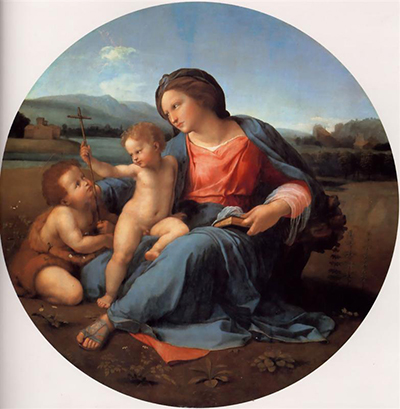The Alba Madonna painting was created in 1510 by Raphael during the High Renaissance period. This painting is 94.5 cm in diameter ( 37 1⁄4 in) and is believed to have been commissioned by Paolo Giovio.
However, some people believe it could have been commisioned by Pope Julius II, who Raphael worked for during 1510. This painting depicts three figures all facing the cross. They represent the Madonna carrying Saint John the Baptist and the Christ as children. The picture has a lot of symbolism, with Madonna displayed wearing a blue mantle, which set against a red dress. The blue colour symbolises the church while the red colour symbolises the death of Christ, and the Madonna unites the Church the sacrifice of Christ. In her lap, Madonna holds Christ, who extends his arm to touch the cross that John is carrying.
Raphael created this piece of art while in Florence, and it shows a landscape backdrop that puts the scene in the Tuscan setting. John the Baptist was a patron of Florence. Therefore, his presence in this Florentine setting is symbolic. Raphael designed this art using oil on panel techniques, and the painting was then mounted on canvas. Panel painting involved the construction of a panel which would be used to lay out the art. A carpenter would cut out a solid piece of wood and shape it into the size of board required. The wood would then be coated with an alloy of resin and animal-skin glues (size) and covered with linen.
After the size had dried, the artist would then apply layers of gesso to bring out the painting. The standard ancient painting techniques used were encaustic, in the first surviving Byzantine icons and at Al-Fayum, which are both at the Saint Catherine's Monastery. The method uses heated wax for the pigments. This method was replaced by tempera, which was again replaced by oil painting.
The Alba Madonna displays the Roman style which Raphael adapted. The painting shows a delicacy of mood and colour, with images, draped in rose pink, green, and pale blue, set in a glamourised, classical landscape. Madonna is dressed in flowing robes, sandals and an old costume of the turban. The serene, rustic ambience of Raphael's tondo conceals its emotional meaning. The gesture of Christ Child's accepting the cross from John is the centre of attention among the three figures. It`s if they have predicted Christ's sacrifice for humanity.
Leonardo's influence on Raphael`s work is apparent in this composition from the appearance of the arrangement of the figures into the pyramidal composition. The pyramidal composition is one thing that Raphael would have learned in Leonardo’s drawing of “The Virgin and Child with St. Anne”. The picture was in a church in Florence. Today, many artists have been inspired by the works of Raphael, and most of them have reproduced his notable paintings, including the Alba Madonna.
Raphael has a considerable portfolio of painting, but some of his most notable works include Madonna in the Meadow, The School of Athens, The Madonna of the Pinks, Small Cowper Madonna and Christ Falling on the Way to Calvary. This piece of art is currently at the National Gallery of Art in Washington, D.C.




